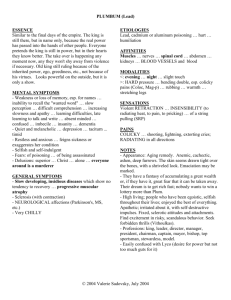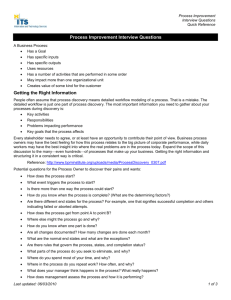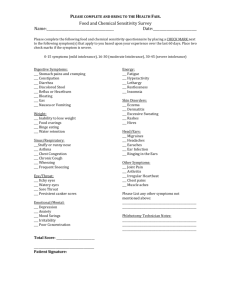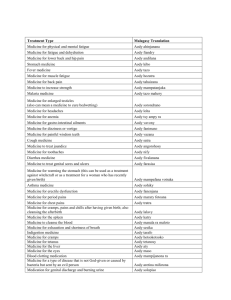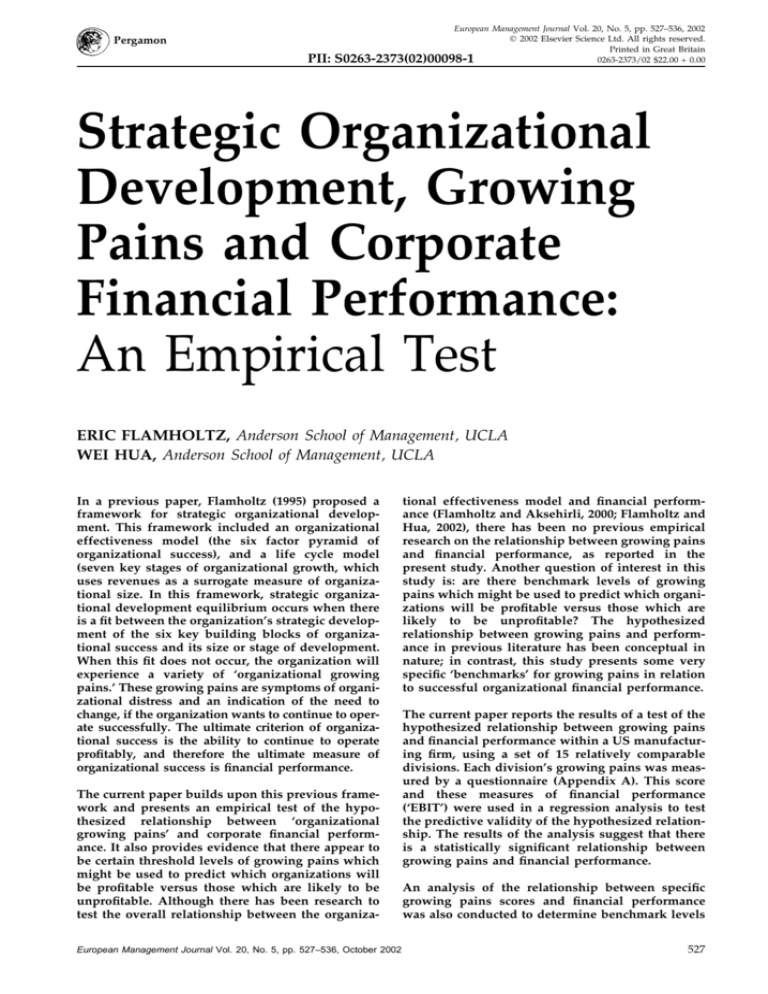
Pergamon
PII:
European Management Journal Vol. 20, No. 5, pp. 527–536, 2002
2002 Elsevier Science Ltd. All rights reserved.
Printed in Great Britain
S0263-2373(02)00098-1
0263-2373/02 $22.00 + 0.00
Strategic Organizational
Development, Growing
Pains and Corporate
Financial Performance:
An Empirical Test
ERIC FLAMHOLTZ, Anderson School of Management, UCLA
WEI HUA, Anderson School of Management, UCLA
In a previous paper, Flamholtz (1995) proposed a
framework for strategic organizational development. This framework included an organizational
effectiveness model (the six factor pyramid of
organizational success), and a life cycle model
(seven key stages of organizational growth, which
uses revenues as a surrogate measure of organizational size. In this framework, strategic organizational development equilibrium occurs when there
is a fit between the organization’s strategic development of the six key building blocks of organizational success and its size or stage of development.
When this fit does not occur, the organization will
experience a variety of ‘organizational growing
pains.’ These growing pains are symptoms of organizational distress and an indication of the need to
change, if the organization wants to continue to operate successfully. The ultimate criterion of organizational success is the ability to continue to operate
profitably, and therefore the ultimate measure of
organizational success is financial performance.
The current paper builds upon this previous framework and presents an empirical test of the hypothesized relationship between ‘organizational
growing pains’ and corporate financial performance. It also provides evidence that there appear to
be certain threshold levels of growing pains which
might be used to predict which organizations will
be profitable versus those which are likely to be
unprofitable. Although there has been research to
test the overall relationship between the organizaEuropean Management Journal Vol. 20, No. 5, pp. 527–536, October 2002
tional effectiveness model and financial performance (Flamholtz and Aksehirli, 2000; Flamholtz and
Hua, 2002), there has been no previous empirical
research on the relationship between growing pains
and financial performance, as reported in the
present study. Another question of interest in this
study is: are there benchmark levels of growing
pains which might be used to predict which organizations will be profitable versus those which are
likely to be unprofitable? The hypothesized
relationship between growing pains and performance in previous literature has been conceptual in
nature; in contrast, this study presents some very
specific ‘benchmarks’ for growing pains in relation
to successful organizational financial performance.
The current paper reports the results of a test of the
hypothesized relationship between growing pains
and financial performance within a US manufacturing firm, using a set of 15 relatively comparable
divisions. Each division’s growing pains was measured by a questionnaire (Appendix A). This score
and these measures of financial performance
(‘EBIT’) were used in a regression analysis to test
the predictive validity of the hypothesized relationship. The results of the analysis suggest that there
is a statistically significant relationship between
growing pains and financial performance.
An analysis of the relationship between specific
growing pains scores and financial performance
was also conducted to determine benchmark levels
527
ORGANIZATIONAL DEVELOPMENT
of ‘safe’ versus ‘unsafe’ growing pains. The results
suggest that there appears to be a maximum level
of growing pains beyond which organizational financial health is at risk. These findings have potentially significant implications for management
theory and practice.
2002 Elsevier Science Ltd. All rights reserved.
Keywords: Organizational development, Financial
performance, Strategy, Growing pains, Bottom line
Background
This paper builds upon previous research on strategic organizational development and financial performance (Flamholtz, 1995; Flamholtz and Aksehirli,
2000; Flamholtz and Hua, 2002).
Our basic premise is that when an organization
grows it will almost inevitably experience a classic
set of ‘growing pains.’ These growing pains are
‘symptoms’ that something has gone wrong in the
process of strategic organizational development, and
an ‘early warning’ of significant future problems.
More specifically, strategic organizational development equilibrium occurs when there is a fit between
the development of the six key building blocks of
organizational success and the organization’s size or
stage of development (Flamholtz, 1995). When this
fit does not occur, the organization will experience a
variety of ‘organizational growing pains.’
As we shall see below, organizational growing pains
can directly influence financial performance or the
so-called ‘bottom line.’ As a result, management
needs: (1) to understand the nature and causes of
growing pains, (2) to have a method of measuring
them, and (3) a template to assess their severity. Our
intent is to provide this set of managerial tools below.
We shall also present the results of an empirical
study designed to: (1) test the hypothesized relationship between ‘organizational growing pains’ and corporate financial performance, and (2) to provide evidence that there appear to be certain threshold levels
of growing pains which might be used to predict
which organizations will be profitable versus those
which are likely to be unprofitable.
First, we will describe the ten classic or most common
‘growing pains,’ which we have identified in our
work and research with organizations (Flamholtz,
1995; Flamholtz and Randle, 2000). Next we will
explain the causes of growing pains in organizations.
Then, we shall present an empirical test of the predictive relationship between growing pains and financial performance in a medium-sized company with
several divisions. We will also show how growing
pains can be used as leading indicators of future
organizational performance, and especially organizational distress. Specifically, we shall provide evidence
that there appear to be certain threshold levels of
growing pains which might be used to predict which
528
organizations will be profitable versus those which
are likely to be unprofitable. Finally, we will suggest
the implications of this study for managers and
future research.
The Theoretical Framework: Classic
Growing Pains
Based upon our experience in working with a wide
variety of organizations, we have identified ten
classic symptoms of organizational growing pains
(Flamholtz, 1995) and Flamholtz and Randle (2000).
These growing pains, which are summarized in Table
4, Appendix A and described below, were derived
from observations and assessments conducted with
a wide variety of organizations (different sizes and
industries).
1. People feel that ‘there are not enough hours in
the day’.
2. People spend too much time ‘putting out fires.’
3. People are not aware of what other people are
doing.
4. People lack understanding about where the firm
is headed.
5. There are too few good managers.
6. People feel that ‘I have to do it myself if I want to
get it done correctly.’
7. Most people feel that ‘our meetings ar a waste of
time.’
8. When plans are made, there is very little followup, so things just don’t get done.
9. Some people feel insecure about their place in
the firm.
10.The organization continues to grow in sales but
not in profits.
People Feel That There Are Not Enough Hours In
The Day
People feel they can work 24 hours a day, seven days
a week and still not get all the required work done.
When employees believe that they are being endlessly overworked morale problems can occur.
People may simply decide they can no longer operate
under these conditions and may leave the organization. This will result in significant turnover costs and
replacement costs related to recruiting, selecting, and
training new people.
People Spend Too Much Time ‘Putting Out Fires’
This means that people are faced with an almost endless series of crises or ‘fires.’ Examples of ‘putting out
fires’ problems are easy to find. ‘Fires’ or crises were
so prevalent at one $50 million manufacturing company in the US, that thirty-three managers began to
European Management Journal Vol. 20, No. 5, pp. 527–536, October 2002
ORGANIZATIONAL DEVELOPMENT
refer to themselves as ‘fire fighters,’ and senior management rewarded middle management for their
skills in handling crises. When it became apparent
that managers who had been effective in ‘fire prevention’ were being ignored, some of them became
‘arsonists’ to get senior management’s attention.
People Are Not Aware Of What Other People Are
Doing
This creates a situation in which people and departments do whatever they want to do and say that the
remaining tasks are ‘not our responsibility.’ Constant
bickering between people over responsibility for
things not getting done may ensue.
People Lack Understanding About Where The
Firm Is Headed
Employees may complain that ‘the company has no
clear direction.’ When insufficient communication is
combined with rapid changes, employees may begin
to feel anxious. If anxiety increases to the point where
it becomes unbearable, employees may begin leaving
the firm. It should be noted that turnover of this kind
could be very costly to the company.
There Are Too Few Good Managers
Although the organization may have many people
who hold the title of ‘manager,’ it may not have good
or effective managers. Rapid growth at Apple computer led Steven Jobs to bring in ‘professional managers’ to help manage the company because it had
not developed a cadre of managers as it grew. However, this led to the inevitable culture clash, and to
Jobs’ resignation.
People Feel That ‘I Have To Do It Myself To Get
It Done Correctly’
Increasingly, as people become frustrated by the difficulty of getting things done in an organization, they
come to feel that ‘if I want to get something done
correctly, I have to do it myself.’ Operating under
this mindset departments become isolated from one
another and teamwork becomes minimal.
Most People Feel ‘Our Meetings Are A Waste Of
Time’
Unfortunately, at many companies, meetings have
typically no planned agendas, and often they have
no designated leader. As a consequence, the meetings
become a free-for-all, tend to drag on interminably,
and seldom result in decisions.
European Management Journal Vol. 20, No. 5, pp. 527–536, October 2002
Other complaints about meetings involve lack of follow up on decisions that are made. Meetings are also
ineffective if people ignore the goals that have been
set or fail to monitor their progress toward these
goals.
When Plans Are Made, There Is Very Little
Follow-up So Things Just Don’t Get Done
Recognizing that the need for planning is greater
than in the past, a CEO may introduce a planning
process. People go through the motions of preparing
business plans, but the things that were planned just
don’t get done. In some cases, there is no follow-up
because the company has not yet developed systems
adequate to monitor its goals. In other cases, followup does not occur because personnel have not
received proper training in setting, monitoring, and
evaluating goals.
Some People Feel Insecure About Their Place In
The Organization
Sometimes the Board has become anxious about
problems facing the organization and has therefore
hired a ‘heavy-weight’ manager from outside. This
action may have been accompanied by the termination of one or more current managers. Employees
begin to wonder whether they will be the next to ‘get
the axe.’ In an attempt to protect themselves, they
keep their activities secret and do not ‘make waves.’
This results in isolation and a decrease in teamwork.
When anxiety becomes too high, it may result in morale problems, turnover, or a very political environment.
The Organization Continues To Grow In Sales
But Not In Profits
If all the other growing pains are permitted to exist,
this final symptom may emerge. In some instances,
sales continue to increase while profits remain flat,
so that the company is succeeding in only increasing
its workload. In the worst cases, sales increase while
overall profits decline.
This set of classic growing pains are not only problems in and of themselves, we believe that they are
symptoms of a deeper problem, and a ‘signal’ or
warning that the organization needs to make a fundamental change in its infrastructure, as explained
below. Although it is tempting to look at growing
pains from a binary (‘yes’ or ‘no’) perspective, as we
shall explain below it is more useful to view them on
a continuum, i.e., the degree to which they exist in a
particular organization.
529
ORGANIZATIONAL DEVELOPMENT
Nature And Causes Of Organizational
Growing Pains
Growth, though essential to organizations over the
long term, creates its own set of problems: the growing pains described above. These growing pains are
symptoms that something has gone wrong in the
growth and development of a business enterprise.
They are a symptom of organizational distress, and
an early warning or leading indicator of future
organizational difficulties, including financial difficulties.
We believe that growing pains indicate that the
‘infrastructure’ of an enterprise (i.e., the internal
operational and management systems it needs at a
given stage of growth) has not kept up with its size,
as measured by its revenues. For example, a business
with $200 million (US) in revenues may only have an
infrastructure to support the operations of a firm
with $50 million in revenues, or one-fourth its size.
This type of situation typically occurs after a period
of growth, sometimes quite rapid growth, where the
infrastructure has not been changed to adjust to the
new size and complexity of the organization. The
result, as shown in Figure 1, is an ‘organizational
development gap,’ (that is, a gap between the organization’s actual infrastructure and that required at its
current size or stage of development) which produces the growing pains.
As a rule of thumb, whenever an organization
doubles in size (as measured by its revenues), it is
essentially a different company and requires a new
infrastructure to support its operations. If the infrastructure has not been adjusted to reflect the
increased size a variety of classic growing pains will
be experienced.
Growing pains can and do occur in organizations of
all sizes, including the largest industrial enterprises.
However, they are most characteristic of early stage
entrepreneurial companies, even in those organizations where revenues exceed $1 billion. Although
growing pains are the result of organizational success
(i.e., successful development of a market and
product), they can lead to great difficulties and even
foreshadow failure. For example, Osborne Computers, a pioneer in the portable ‘personal’ (micro)
computers business, achieved $100 million in revenues after being in business for only two years, but
went into bankruptcy in year three!
Measuring Growing Pains
What happened to Osborne Computers is not an isolated incident; rather, it is a predictable, classic reaction to ‘hyper growth.’ It would have been useful to
Osborne to have had a tool to measure their growing
pains and to also have had some benchmarks of ‘safe’
and ‘unsafe’ growing pains.
We have developed a technique for measuring growing pains and the degree of organizational distress
they represent (see Appendix A). This technique
involves using a Likert scale to measure the extent to
which people perceive that the ten classic growing
pains exist in their enterprise or business unit. This
enables us to measure the growing pains on a continuum, i.e., the degree to which they exist in a particular organization.
Growing Pains and Financial
Performance
Based upon our experience in working with organizations, we have long believed that organizational
Figure 1 Organizational Development Gap
530
European Management Journal Vol. 20, No. 5, pp. 527–536, October 2002
ORGANIZATIONAL DEVELOPMENT
growing pains can be used to predict the financial
performance or so-called ‘bottom line’ of enterprises,
especially future organizational distress. However,
there has been no previous empirical research on the
relationship between growing pains and financial
performance. In this section, we shall present a study
of growing pains and financial performance or the
so-called ‘bottom line.’
The current paper builds upon the framework
presented above and presents an empirical test of the
hypothesized relationship between ‘organizational
growing pains’ and corporate financial performance.
Another questions is: are there benchmark levels of
growing pains which might be used to predict which
organizations will be profitable versus those which
are likely to be unprofitable? The hypothesized
relationship between growing pains and performance in previous literature has been conceptual in
nature; in contrast, this study presents some very
specific ‘benchmarks’ for growing pains in relation to
successful organizational financial performance.
Research Design
The current paper reports the results of a test of the
hypothesized relationship between growing pains
and financial performance within a US manufacturing firm, using a set of fifteen relatively comparable
divisions. Another question of interest in this study
is: are there benchmark levels of growing pains
which might be used to predict which organizations
will be profitable versus those which are likely to be
unprofitable? The hypothesized relationship between
growing pains and performance in previous literature has been conceptual in nature; in contrast, this
study presents some very specific ‘benchmarks’ for
growing pains in relation to successful organizational
financial performance. And therefore the ultimate
measure of organizational success is financial performance.
An analysis of the relationship between specific
growing pains scores and financial performance was
also conducted to determine benchmark levels of
‘safe’ versus ‘unsafe’ growing pains. The results suggest that there appears to be a maximum level of
growing pains beyond which organizational financial
health is at risk.
Research Site Description: ‘Banner Corporation’. The
company (for which we shall use the pseudonym,
‘Banner Corporation’) is a U.S.-based, medium-sized
industrial enterprise. Banner represents the classic
‘old economy.’ The company is a parts manufacturer
for industrial, truck and other automotive businesses.
It is a supplier of parts for such companies as Ford
Motor Company, Navistar, and Dana Corporation.
Reasons for the Study. The company was formed primEuropean Management Journal Vol. 20, No. 5, pp. 527–536, October 2002
arily through acquisitions in a classic ‘roll up’ strategy, a strategy of industry consolidation through
acquisitions. It consisted of several different
‘divisions,’ each of which had been stand alone
entrepreneurial companies, with revenues ranging
from about $25 million annually to about $100
million. Altogether, the divisions totaled about $800
million in annual revenue at the time of this study.
These divisions consisted of a set of reasonably
related technologies, such as foundries and forges.
The foundries ranged from processing capacity for
‘grey iron’ to ‘ductile iron’ to ‘lost foam’ to other
similar technologies. The nature of the business of
such entities is ‘job order manufacturing.’
The similarities between the divisions present a relatively unique opportunity for comparison. The company had been formed from a set of stand-alone companies. Each of the individual companies, or
‘divisions,’ as they were termed, operated in various
parts of the United States.
The company was engaged in making a fundamental
change in corporate strategy. Specifically, the ‘old’
strategy had been to consolidate a fragmented industry and allow the individual companies (divisions) to
operate autonomously, with a few corporate policies
and systems. The ‘new’ strategy was to leverage the
company’s critical mass and use its combined
resources to serve large clients, such as Ford, Navistar, Dana, etc. This required a cooperative effort
among the divisions of sales and order fulfillment.
Research Question and Methodology. The primary
research question this article addresses is: Is there a
predictive relationship between the degree of organizational growing pains (as measured above) and the
financial performance of an organization?
The following hypothesis was used to assess this:
H1: The lower the growing pains of an organization, the
higher its financial performance and vice versa.
Organizational growing pains are like cholesterol:
with respect to human health, lower cholesterol is
better than higher cholesterol. Similarly, with respect
to organizational health and success, lower growing
pains are better than higher growing pains.
Related Research Question. Another question of interest
in this study is: are there threshold levels of growing
pains which might be used to predict which organizations will be profitable versus those which are
likely to be unprofitable?
Research Strategy. This section describes the methodology for the research. This study was part of an
overall program of strategic organizational development at Banner Corporation. Since the company had
grown rapidly through acquisitions, it had experienced a great many growing pains. One of the first
531
ORGANIZATIONAL DEVELOPMENT
steps in the program of strategic organizational
development was to conduct an organizational
assessment. This involved a combination of interviews as well as the administration of an ‘organizational growing pains questionnaire’ (see Table 4,
Appendix A).
Measurement of Variables. Data on the financial performance of the divisions was available as part of the
normal accounting process, and was the measure
used to evaluate divisional performance. In this
study, financial performance was measured as ‘EBIT,’
or ‘earnings before interest and taxes,’ as a percentage of revenues (‘% EBIT’). ‘Growing Pains’ were
measured by means of the organizational growing
pains questionnaire (see Table 4, Appendix A). The
questionnaire lists ten classic symptoms of ‘Organizational Growing Pains.’ Each division’s growing
pains was measured by the growing pains questionnaire. The questionnaire was administered to a total
of 149 people across all of the company’s divisions.
All respondents were managers.
This score and measures of financial performance
(‘EBIT) were used in a regression analysis to test the
predictive validity of the hypothesized relationship.
Findings
As discussed below, the results of the analysis suggest that there is a (very strong) statistically significant relationship between growing pains and financial performance. The results also suggest that there
appears to be a maximum level of growing pains
beyond which organizational financial health is at
risk.
Growing Pains and % EBIT. The growing pains scores
and the related % EBIT for 15 divisions are shown in
Table 1. By inspecting this table we can see that the
Table 1
divisions with the lowest growing pains scores tend
to have the highest EBIT numbers. This suggests that
there is an inverse relationship between growing
pains and EBIT. Stated differently, the lower the
growing pains the higher the EBIT, and vice versa. The
relationship or correlation between these two sets of
variables (growing pains and % EBIT) is shown
graphically in Figure 2 (Flamholtz and Randle, 2000).
To study whether there is a statistically valid predictive relationship between growing pains and EBIT,
we calculated a regression equation based upon these
two variables. The results of this statistical test indicate that there is a statistically significant relationship
between growing pains as a predictor of EBIT.1 The
data suggest that approximately 49 per cent of EBIT
is explained by the organizational growing pains.
This relationship is significant at the 0.0035 level, a
very high level of statistical significance. This means
that growing pains are a predictor of financial performance or the ‘bottom line’ (EBIT).
Growing Pains and Levels of Profitability. An analysis
of the relationship between specific growing pains
scores and financial performance was also conducted
to determine benchmark levels of ‘safe’ versus
‘unsafe’ growing pains. The results suggest that there
appears to be a maximum level of growing pains
beyond which organizational financial health is at
risk.
As seen in Table 1, all of the divisions (1–9) with
growing pains scores less than ‘28’ are profitable.
However, for those divisions with growing pains
greater than 28 (divisions 10–15), 50 per cent are
profitable and 50 per cent are unprofitable (negative
EBIT). This suggests that there is a ‘maximum healthy growing pains score’ to provide the highest probability of success, and confirms that there do appear
to be threshold levels of growing pains which might
Growing Pains and % EBIT∗
Growing Pains
% EBIT
Division
Score
Rank
Score
1
2
3
4
5
6
7
8
9
10
11
12
13
14
15
16.88
18.50
20.00
20.38
21.86
22.50
24.00
25.38
27.90
28.12
28.60
31.91
32.02
33.00
34.43
1
2
3
4
5
6
7
8
9
10
11
12
13
14
15
15.23
10.22
7.25
14.31
11.89
8.47
6.24
2.41
3.11
⫺11.17
11.13
⫺1.77
4.25
0.87
⫺2.24
Rank
1
5
7
2
3
6
8
11
10
15
4
13
9
12
14
∗EBIT is measured as a % of revenues for each division
532
European Management Journal Vol. 20, No. 5, pp. 527–536, October 2002
ORGANIZATIONAL DEVELOPMENT
Figure 2 EBIT vs Growing Pains.
∗ y = ⫺0.8857 × +28.107, F = 12.68, p = 0.0035, R2 = 0.50, adjR2 = 0.54.
Table 2
Average Growing Pains Score Versus Average % EBIT for Two Sets of Divisions
Growing Pains Score
%EBIT
Divsions
Average
Range
Average
Range
1–9
10–15
21.93
31.35
16.88–27.90
28.12–34.43
8.79
0.18
2.41–15.23
⫺11.17–11.13
be used to predict which organizations will be
profitable versus those which are likely to be
unprofitable.
This is also shown in summary form in Table 2,
which presents the average growing pains and
related average %EBIT for the two sets of divisions
(1–9 and 10–15). Upon inspection, we can see that
there is a clear difference between the average %
EBIT for the two sets of divisions.
Another way to look at the relationship between the
level of growing pains and EBIT is presented in Table
3. Using a ‘2×2 table’ growing pains scores are cateTable 3 Relation
Between
Growing
(Low/High) and EBIT% (Positive/Negative)
Pains
EBIT
Growing Pains Score
Low
High
Negative
Positive
0
3
9
3
European Management Journal Vol. 20, No. 5, pp. 527–536, October 2002
gorized as either ‘low’ (less than 27.90) or ‘high’
(greater than 28.12), and EBIT is categorized as either
‘positive’ or ‘negative’. Table 3 shows the distribution
of these 15 divisions in this way.
Based upon these observations, we ran a series of
statistical exercises to test for significance and to
derive theoretical values of benchmark levels of ‘safe’
versus ‘unsafe’ growing pains. To test for the statistical significance of the relationship between growing
pains score and EBIT, we ran a t- test and a threshold
calculation by the regression equation. First, to test
for significant differences between the average growing pains score between division 1–9 and division 10–
15, we ran a t-test for equality of means. The result
is: t = ⫺5.725 (df = 13, P = 0.0035). This means that
division 1–9 has a statistically significant lower average growing pains score than division 10–15.
Second, we ran a t-test for equality of means for EBIT
in these two groups. The results is: t = 2.806
(df = 13, P = 0.015). This means that division 1–9 has
533
ORGANIZATIONAL DEVELOPMENT
a statistically significant higher average EBIT than
divisions 10–15.
Implications For Management, Boards,
And Auditors
Then we used the regression equation derived
Given these findings, it appears that growing pains
between EBIT and growing pains score: EBIT = ⫺
can be used as leading indicators of future financial
0.8857 × Growing Pains Score + 28.107. Statistically,
performance. The U.S. Federal Reserve monitors
we let EBIT equal zero to calculate the threshold level
leading indicators of economic activity to predict the
of growing pains score. The value turned out to be
direction of GNP and inflation. Similarly, growing
31.73. In other words, given a population of firms
pains might be used as leading indicators of future
with continuous Growing Pains
changes in organizational finScores, any firm with a score
performance.
In
If a company anticipates ancial
less than 31.73 will yield a posiaddition, our findings concerntive EBIT (being profitable),
ing the maximum level of
rapid growth, then
while any firm with a score
growing pains in relation to the
more than 31.73 will yield a
levels of profitability are, at a
management must invest in minimum, suggestive of the
negative
EBIT
(being
unprofitable).
need to control or at least minbuilding the required
imize growing pains.
Thus although the actual data
Our findings also have impliinfrastructure before it is
set shows that the threshold for
cations for Boards of Directors
safe growing pains is 28, these
and external auditors. Recent
actually necessary
tests indicate that the true
experiences in the US, with
theoretical value for safe growEnron, Waste Management,
ing pains is 32. This means that to optimize the
and other publicly traded enterprises suggest the
chances of being profitable an organization needs to
need for improved methods of control (Flamholtz,
keep its growing pains score less than 32.
1996; Nilsson and Olve, 2001). There are complex
issues involving the balance of power among management, Boards, and auditors not only in the US,
but throughout Europe and Asia as well ( Hooghiemstra and Van Manen, 2002). What is required are tools
that can help identify potential problems before they
Conclusions, Implications, And Future
occur.
Research
The data derived from this study provide empirical
support for the notion that growing pains have an
impact on financial performance, and that there are
threshold levels of growing pains that are ‘unsafe’
or ‘unhealthy’ for future financial performance. Each
division’s growing pains was measured by a questionnaire (Table 4, Appendix A). This score and these
measures of financial performance (EBIT) were used
in a regression analysis to test the predictive validity
of the hypothesized relationship. The results of the
analysis suggest that there is a statistically significant
relationship between growing pains and financial
performance. The results also suggest that there
appears to be a maximum level of growing pains
beyond which organizational financial health is at
risk. Specifically, the maximum ‘healthy’ level of
growing pains appears to be ‘32.’ This means that to
optimize the chances of being profitable an organization ought to keep its growing pains score less than
32. In terms of the color-coding scheme used with the
growing pains questionnaire (Table 4, Appendix A),
this is at the beginning level of the ‘orange’ zone2 (the
zones are: green, yellow, orange, red, and purple).
These findings have significant implications for management theory and practice.
534
Since growing pains can be measured and we have
shown that they are clearly linked to financial performance, it would be useful to report growing pains
to the Board. This would be done on a comparative
basis across time. Independent auditors might also
find this information useful as a signal to look for
organizational problems.
Managing Growing Pains
What should an organization do to minimize or
avoid the problems associated with growing pains?
Most entrepreneurs are concerned with the risk of
failure if revenues are insufficient to cover expenses.
However, many ignore the equally damaging risks
of choking on their own rapid growth. To avoid the
problems accompanying hyper-growth, a company
must have an infrastructure that will absorb that
growth. If a company anticipates rapid growth, then
management must invest in building the required
infrastructure before it is actually necessary. It is very
difficult, and sometimes impossible, to ‘play catchup’ with organizational infrastructure.
Some companies, such as Starbucks Coffee, Compaq
Computer, and PacifiCare had a strategy of having
European Management Journal Vol. 20, No. 5, pp. 527–536, October 2002
ORGANIZATIONAL DEVELOPMENT
their infrastructure in place prior to their explosive
growth and reaped the benefits of this investment. In
contrast, Boston Markets, Osborne Computers, and
MaxiCare, did not have their infrastructure in place
prior to explosive growth and all three have experienced bankruptcy.
Thus the ideal strategy for a firm that anticipates
rapid growth is to build an infrastructure sufficient
for the size of the organization it anticipates becoming prior to actually reaching that size.
This strategy of building the infrastructure prior to
growth is not merely appropriate for large companies, but for relatively small entrepreneurships as
well. For example, several years ago, one of the
authors met with the president of a US service firm
specializing in insurance-based benefit programs for
executives when the firm had approximately $3
million in annual revenues. At that time, the authors
of this article advised the CEO that it was probably
premature to build the infrastructure to the extent
that was being contemplated. However, the CEO
indicated that he wanted his firm to grow to $50
million in revenue within five years. He then proceeded to invest in building the infrastructure of his
company before it was actually necessary. This was
a wise move, because the company actually grew to
more than $65 million in revenue within five years.
Future Research
From an academic perspective, the results reported
here are preliminary but promising. It would be valuable for future research to replicate the current study,
not only in a North American environment but in
Europe and Asia as well. However, this will require
a research site comparable to Banner Corporation,
which offers the benefits of a set of comparable business units. This is not easy to find in practice.
Conclusion
This article has examined the relationship between
growing pains and financial performance. It has
identified the most common organizational growing
pains. It has also presented a method for assessing
the extent to which a company suffers from these
growing pains. The company’s score on the Organizational Growing Pains Questionnaire can suggest
both the extent of its problems and specific needs for
action. It has provided information on the levels of
organizational growing pains that differentiate
profitable from unprofitable enterprises. Finally, it
has also examined the relationship between growing
pains and financial performance, and shown that
there is a statistically significant predictive relationship. The results have significant implications for
managerial theory and practice.
Variations exist here, but it is clear that organizations
of all sizes and types experience some growing pains.
European Management Journal Vol. 20, No. 5, pp. 527–536, October 2002
Severity of these problems can be affected by the rate
of growth experienced by the organization. Managers
of rapidly growing companies of any size or type
must learn to recognize organizational growing pains
and take steps to alleviate them so that their organizations can continue to operate successfully. The payoff will be reduced growing pains and an increased
likelihood of a positive ‘bottom line.’
Acknowledgements
The authors gratefully acknowledge that the research
reported in this paper was partly supported by the Harold
Price Center for Entrepreneurial Studies in the Anderson
School at UCLA.
Appendix A
Measuring Organizational Growing Pains:
To assist in measuring the extent of the growing pains
in entrepreneurial companies, a questionnaire has
been developed (Table 4, Appendix A) from work
with a wide variety of entrepreneurial companies with
annual sales revenues ranging from less than $1
million to over $1 billion. By placing check marks in
the columns ranging from ‘To a Very Great Extent’ to
‘To a Very Slight Extent,’ the respondent can measure
the extent to which he or she feels each of the ten
growing pains characterize his or her company.
Score Interpretation:
Scores ranging from 10 to 14 are color-coded ‘green,’
representing a fairly healthy organization. It suggests
that everything is functioning satisfactorily for the
organization at its current stage of development.
A score ranging from 15 to 19 corresponds to the
color ‘yellow,’ signifying that there are some things
to watch. The organization is basically healthy, but
there are some areas that may need attention.
A score ranging from 20 to 29 is color-coded ‘orange,’
indicating that some organizational problems require
attention. They may not be serious yet, but corrective
action should be taken.
Scores ranging from 30 to 39 are color-coded ‘red,’
indicating that some very significant problems exist
within the organization. Immediate corrective action
is required. A ‘purple’ score with numbers ranging
between 40 and 50 indicates a dangerous, perhaps
deadly, situation. The organization is in distress and
may be on the verge of collapse. There may not be
enough time to save it.
535
ORGANIZATIONAL DEVELOPMENT
Table 4
Appendix A: Growing Pains Questionnaire
Growing Pains
A
B
C
D
E
To a Very
Great Extent
To a Great
Extent
To Some
Extent
To a Slight
Extent
To a Very
Slight Extent
1.
People feel that there are not enough hours in
the day
2. People are spending too much time ‘putting out
fires.’
3. Many people are not aware of what others are
doing.
4. People lack understanding of where the firm is
heading.
5. There are too few good managers.
6. Everybody feels ‘I have to do it myself if I want
to get it done correctly.’
7. Most people feel our meetings are a waste of
time.
8. When plans are made, there is very little followup and things just don’t get done
9. Some people feel insecure about their place in
the firm.
10. The firm has continued to grow in sales but not
in profits.
A score higher than 20 may very well signal that the
firm has reached a new stage in its development and
must make major, qualitative changes.
Notes
1. The regression equation is: y = ⫺0.8857x + 28.107.
R2 = 0.4936, and is statistically significant at 0.0035.
2. This is consistent with what we have been telling our consulting clients for some years: that, based on our experience, growing pains should not exceed the lower orange
zone, or else an organization can be at risk. Now there is
statistical confirmation of this observation.
References
Flamholtz, E. (1995) Managing organizational transitions:
implications for corporate and human resource management. European Management Journal 13(1), 39–51.
Flamholtz, E.G. and Aksehirli, Z. (2000) Organizational suc-
cess and failure, an empirical test of a holistic model.
European Management Journal 18(5), 488–498.
Flamholtz, E. and Hua, Wei (2002) Strategic organizational
development and the bottom line: further empirical evidence. European Management Journal 20(1), 72–81.
Flamholtz, E. (1996) Effective organizational control. A framework, applications, and implications. European Management Journal 14(6), 596–611.
Flamholtz, E. and Randle, Y. (2000) Growing Pains: Transitioning from an Entrepreneurship to a Professionally Managed Firm. Jossey-Bass, San Francisco.
Flamholtz, E. and Randle, Y. (1998) Changing the Game: Organizational Transformations of the First, Second and Third Kinds.
Oxford University Press, New York.
Hooghiemstra, R. and Van Manen, J. (2002) Supervisory,
directors, and ethical dilemma: exit or voice? European
Management Journal 20(1), 1–9.
Nilsson, F. and Olve, N. (2001) Control systems in multinational companies: from performance management to
strategic management. European Management Journal
19(4), 344–358.
ERIC FLAMHOLTZ, The
Anderson Graduate School
of Management, HROB,
110 Westwood Plaza, Ste
A416, Box 951481, Los
Angeles, CA 90095, USA.
E-mail: ef@mgtsystems.com.
WEI HUA, The Anderson
Graduate School of Management, HROB, 110 Westwood Plaza, Ste A416, Box
951481, Los Angeles, CA
90095, USA. E-mail: wei.hua@anderson.ucla.edu.
Dr Eric Flamholz is Professor of Management at
UCLA, and President of the
Management Systems Consulting Corporation which he founded in 1978. A prolific author, he is currently working on a book dealing
with strategy and executive leadership.
Weu Hua is a doctoral candidate of organizational
behaviour
and
human
resource management at
UCLA. Her research interests include organizational
demography, trust and organizational culture.
536
European Management Journal Vol. 20, No. 5, pp. 527–536, October 2002




